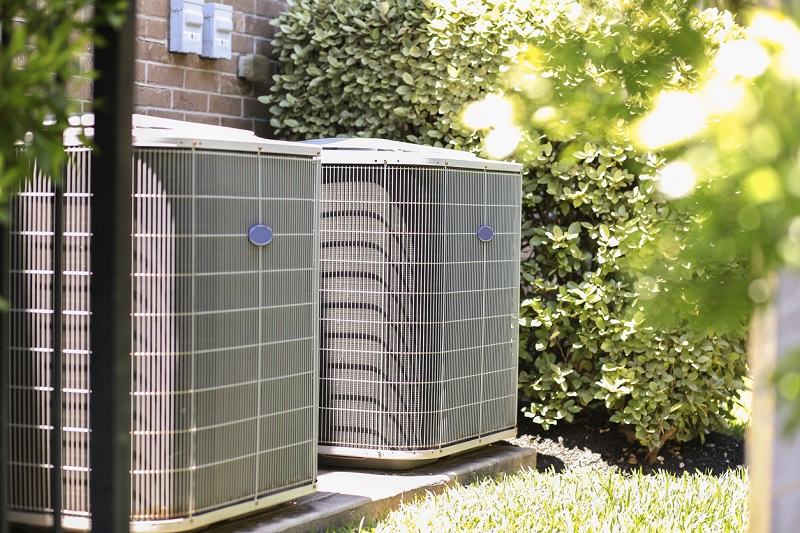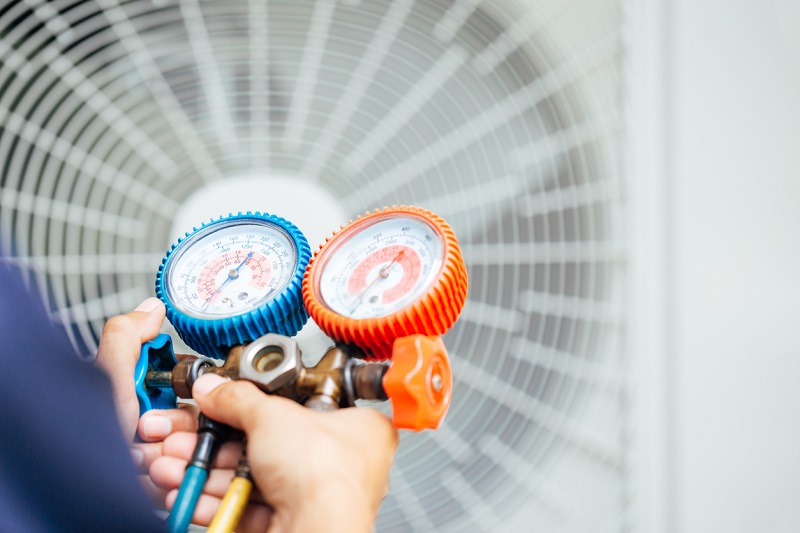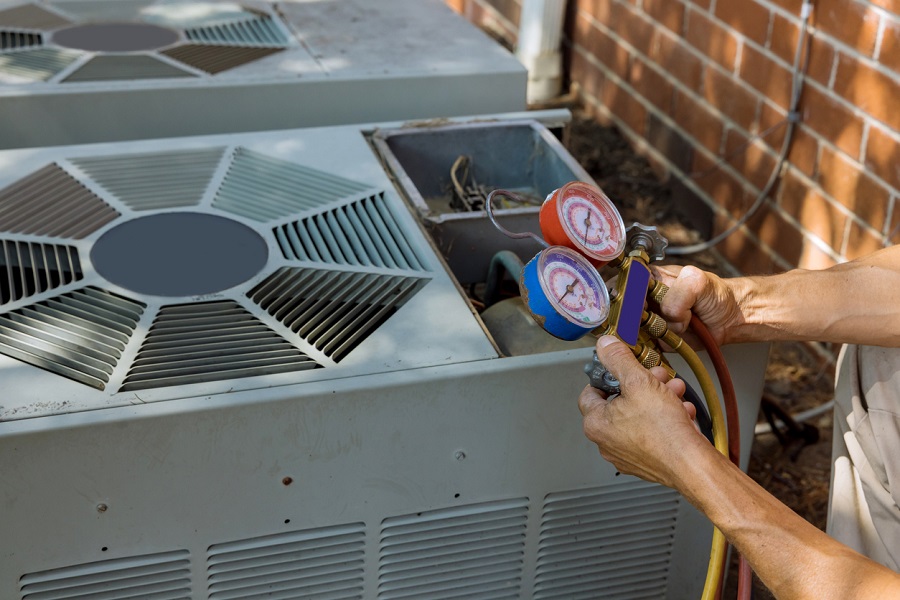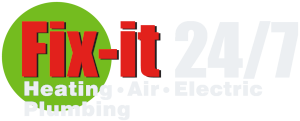How Does An AC Unit Work? – Detailed Steps On How Your Air Conditioning Works 2022
Air conditioner units are complex systems with many moving parts. Yet, the system is also fairly simple once you understand it. So today we will look at how an AC unit works so that you can better diagnose any problems you may have in the future.
 1. Setting the thermostat to the desired temp
Set your thermostat to the desired temp to begin using your AC unit. Regardless if you select hot or cold, the thermostat is needed for both functions.
2. The condenser and compressor turn on
When you activate the thermostat, the condenser and compressor turn on and begin to circulate air. The condenser pumps a liquid known as a refrigerant.
3. Condenser pumps refrigerant
The condenser begins circulating a liquid known as refrigerant throughout the system.
4. Refrigerant goes from vapor to liquid
Converting vapor to a liquid allows the transportation of heat from inside your home to outside. heat
5. Compressors change refrigerant to vapor
Refrigerant enters the compressor as a low temperature, low-pressure vapor. The compression process turns it into a high-temperature, high-pressure vapor.
6. Travels through condenser into liquid
The vapor that the compressor pressurizes travels through the condenser coils, which condense it into a liquid. The heat that is collected through this process is released outside with the help of a fan.
7. Condenser liquid flows to the metering device
The liquid from the condenser is turned into a medium temperature high, pressure liquid that flows to a metering device.
8. Thermal Expansion Valve
A thermal expansion valve controls the rate at which condensing liquid travels into the metering device. Medium temperature, high-pressure liquid travels through the valve and produces a vapor/liquid mix that is low temperature, low pressure.
9. The chilled refrigerant flows through the evaporator coil
The low-temperature vapor/liquid mixture flows through the evaporator coil.
10. The Blower Circulates Air
The chilled refrigerant is pushed to a blower which then begins to circulate air throughout the house.
11. Air pulled into the return ducts and passed through a filter
Room temperature air is pulled through the return ducts and passed through a filter to remove any particles or dust.
12. Heat from the air is absorbed by the refrigerant in the evaporator coil
The heat from the air is then absorbed by the refrigerant inside the evaporator coil, dispersing chilled air through the supply duct.
13. Refrigerant goes back into vapor form
As the air passes through the coil, the refrigerant is boiled and evaporates into a vapor form.
14. Condensation forms outside on the coil
As the refrigerant is boiled and evaporates, condensation will form on the outside of the coil and is piped through the condensation drain line.
15. The refrigerant returns to the condenser with the collected heat
The refrigerant then returns to the condenser to disperse the collected heat outside.
16. The process starts all over again
The cycle begins again.
1. Setting the thermostat to the desired temp
Set your thermostat to the desired temp to begin using your AC unit. Regardless if you select hot or cold, the thermostat is needed for both functions.
2. The condenser and compressor turn on
When you activate the thermostat, the condenser and compressor turn on and begin to circulate air. The condenser pumps a liquid known as a refrigerant.
3. Condenser pumps refrigerant
The condenser begins circulating a liquid known as refrigerant throughout the system.
4. Refrigerant goes from vapor to liquid
Converting vapor to a liquid allows the transportation of heat from inside your home to outside. heat
5. Compressors change refrigerant to vapor
Refrigerant enters the compressor as a low temperature, low-pressure vapor. The compression process turns it into a high-temperature, high-pressure vapor.
6. Travels through condenser into liquid
The vapor that the compressor pressurizes travels through the condenser coils, which condense it into a liquid. The heat that is collected through this process is released outside with the help of a fan.
7. Condenser liquid flows to the metering device
The liquid from the condenser is turned into a medium temperature high, pressure liquid that flows to a metering device.
8. Thermal Expansion Valve
A thermal expansion valve controls the rate at which condensing liquid travels into the metering device. Medium temperature, high-pressure liquid travels through the valve and produces a vapor/liquid mix that is low temperature, low pressure.
9. The chilled refrigerant flows through the evaporator coil
The low-temperature vapor/liquid mixture flows through the evaporator coil.
10. The Blower Circulates Air
The chilled refrigerant is pushed to a blower which then begins to circulate air throughout the house.
11. Air pulled into the return ducts and passed through a filter
Room temperature air is pulled through the return ducts and passed through a filter to remove any particles or dust.
12. Heat from the air is absorbed by the refrigerant in the evaporator coil
The heat from the air is then absorbed by the refrigerant inside the evaporator coil, dispersing chilled air through the supply duct.
13. Refrigerant goes back into vapor form
As the air passes through the coil, the refrigerant is boiled and evaporates into a vapor form.
14. Condensation forms outside on the coil
As the refrigerant is boiled and evaporates, condensation will form on the outside of the coil and is piped through the condensation drain line.
15. The refrigerant returns to the condenser with the collected heat
The refrigerant then returns to the condenser to disperse the collected heat outside.
16. The process starts all over again
The cycle begins again.

 1. Setting the thermostat to the desired temp
Set your thermostat to the desired temp to begin using your AC unit. Regardless if you select hot or cold, the thermostat is needed for both functions.
2. The condenser and compressor turn on
When you activate the thermostat, the condenser and compressor turn on and begin to circulate air. The condenser pumps a liquid known as a refrigerant.
3. Condenser pumps refrigerant
The condenser begins circulating a liquid known as refrigerant throughout the system.
4. Refrigerant goes from vapor to liquid
Converting vapor to a liquid allows the transportation of heat from inside your home to outside. heat
5. Compressors change refrigerant to vapor
Refrigerant enters the compressor as a low temperature, low-pressure vapor. The compression process turns it into a high-temperature, high-pressure vapor.
6. Travels through condenser into liquid
The vapor that the compressor pressurizes travels through the condenser coils, which condense it into a liquid. The heat that is collected through this process is released outside with the help of a fan.
7. Condenser liquid flows to the metering device
The liquid from the condenser is turned into a medium temperature high, pressure liquid that flows to a metering device.
8. Thermal Expansion Valve
A thermal expansion valve controls the rate at which condensing liquid travels into the metering device. Medium temperature, high-pressure liquid travels through the valve and produces a vapor/liquid mix that is low temperature, low pressure.
9. The chilled refrigerant flows through the evaporator coil
The low-temperature vapor/liquid mixture flows through the evaporator coil.
10. The Blower Circulates Air
The chilled refrigerant is pushed to a blower which then begins to circulate air throughout the house.
11. Air pulled into the return ducts and passed through a filter
Room temperature air is pulled through the return ducts and passed through a filter to remove any particles or dust.
12. Heat from the air is absorbed by the refrigerant in the evaporator coil
The heat from the air is then absorbed by the refrigerant inside the evaporator coil, dispersing chilled air through the supply duct.
13. Refrigerant goes back into vapor form
As the air passes through the coil, the refrigerant is boiled and evaporates into a vapor form.
14. Condensation forms outside on the coil
As the refrigerant is boiled and evaporates, condensation will form on the outside of the coil and is piped through the condensation drain line.
15. The refrigerant returns to the condenser with the collected heat
The refrigerant then returns to the condenser to disperse the collected heat outside.
16. The process starts all over again
The cycle begins again.
1. Setting the thermostat to the desired temp
Set your thermostat to the desired temp to begin using your AC unit. Regardless if you select hot or cold, the thermostat is needed for both functions.
2. The condenser and compressor turn on
When you activate the thermostat, the condenser and compressor turn on and begin to circulate air. The condenser pumps a liquid known as a refrigerant.
3. Condenser pumps refrigerant
The condenser begins circulating a liquid known as refrigerant throughout the system.
4. Refrigerant goes from vapor to liquid
Converting vapor to a liquid allows the transportation of heat from inside your home to outside. heat
5. Compressors change refrigerant to vapor
Refrigerant enters the compressor as a low temperature, low-pressure vapor. The compression process turns it into a high-temperature, high-pressure vapor.
6. Travels through condenser into liquid
The vapor that the compressor pressurizes travels through the condenser coils, which condense it into a liquid. The heat that is collected through this process is released outside with the help of a fan.
7. Condenser liquid flows to the metering device
The liquid from the condenser is turned into a medium temperature high, pressure liquid that flows to a metering device.
8. Thermal Expansion Valve
A thermal expansion valve controls the rate at which condensing liquid travels into the metering device. Medium temperature, high-pressure liquid travels through the valve and produces a vapor/liquid mix that is low temperature, low pressure.
9. The chilled refrigerant flows through the evaporator coil
The low-temperature vapor/liquid mixture flows through the evaporator coil.
10. The Blower Circulates Air
The chilled refrigerant is pushed to a blower which then begins to circulate air throughout the house.
11. Air pulled into the return ducts and passed through a filter
Room temperature air is pulled through the return ducts and passed through a filter to remove any particles or dust.
12. Heat from the air is absorbed by the refrigerant in the evaporator coil
The heat from the air is then absorbed by the refrigerant inside the evaporator coil, dispersing chilled air through the supply duct.
13. Refrigerant goes back into vapor form
As the air passes through the coil, the refrigerant is boiled and evaporates into a vapor form.
14. Condensation forms outside on the coil
As the refrigerant is boiled and evaporates, condensation will form on the outside of the coil and is piped through the condensation drain line.
15. The refrigerant returns to the condenser with the collected heat
The refrigerant then returns to the condenser to disperse the collected heat outside.
16. The process starts all over again
The cycle begins again.
The Important Parts of an Air Conditioner
Below you will find all the components of an air conditioner and their functions:

